
Office
Tel
Ph.D. in Electrical Engineering, Aug. 2005.
M.S. in Electrical Engineering, Feb. 2000.
B.S. in Electrical Engineering, Feb. 1998.
Jaehyoung Park, Dongwook Kim, Hyun Ho Park, Jong Hwa Kwon, Sang Il Kwak, and Seungyoung Ahn, “A Resonant Reactive Shielding for Planar Wireless Power Transfer System in Smart Phone Application,” IEEE Transactions on Electromagnetic Compatibility, 2017.
Seungyoung Ahn, Korean Institute of Electromagnetic Engineering and Science, 2015
Seungyoung Ahn, IEEE Electromagnetic Compatibility Society, for serving as a Distinguished Lecturer, 2021
Seungyoung Ahn, IEEE Microwave Theory and Techniques Society, for organizing IEEE WPTC, 2014
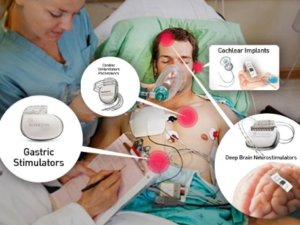 |
(a)
(b) |
| Various of implantable medical device (IMD) | Concept of the IMD with wireless power transfer technology (a) pacemaker, (b) Deep brain stimulator |
As the effectiveness of an implantable medical device such as an artificial pacemaker, neuro-stimulator, or cochlear implant has been proven, it is widely used to treat various diseases. However, such an implantable medical device has a number of problems. The biggest problem is the battery. The battery life of implantable medical devices ranges from two to five years, that is, they need to be replaced every two to five years. In addition, complex structures can damage internal parts of the human body or cause necrosis of surrounding tissues. In order to solve the limitations of the implantable medical device, we are studying the application of wireless power transfer technology to the implantable medical device.In our laboratory, we are focusing on miniaturization of coils, securing safety (heat and electromagnetic wave effects), and improving stimulus performance to apply wireless power transfer technology to pacemaker and neuro-stimulator. The convergence of wireless power transfer technology with biomedical technology, a key field of the fourth industry, can lead the technological development.
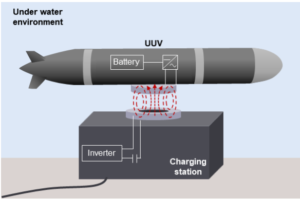
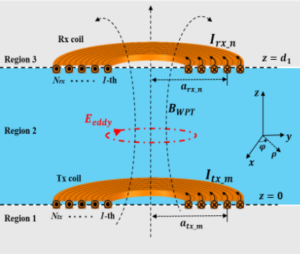
In recent years, the wireless power transfer technology is mainly focused on the inductive coupling method using time-varying magnetic field. Unlike in air, however, time-varying magnetic fields generate eddy current in conductive medium such as seawater. Therefore, new coil modeling method for eddy current loss analysis in conductive medium is being studied.
As WPT(wireless power transfer) technology is improved, attempts to apply it to various applications are increasing. Recently, WPT has been used for the purpose of supplying power to underwater robots that perform construction, resource exploration, and military operations.
Research of WPT mainly focused on the inductive coupling method using time-varying magnetic field. Unlike in air, however, time-varying magnetic fields generate eddy current in conductive medium such as seawater. Therefore, new coil modeling method for eddy current loss analysis in conductive medium is being studied.
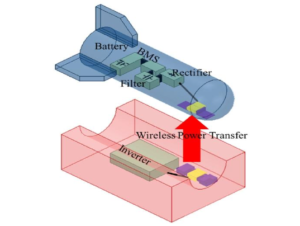 |
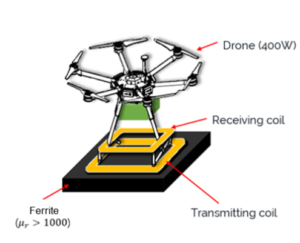 |
| WPT for UAVs (1 kW) | WPT for drone (400 W) |
Recently, unmanned aerial vehicles (UAVs) have been used in various fields such as military, hobby, and industry. There are various types of UAVs such as drones and missiles. Among them, the use of drones becomes particularly important.
We are studying on applying a wireless power transfer system to replace the wired charging system previously adopted in conventional UAVs. The power capacity of the application ranges from tens of W to hundreds of kW, and we are designing power circuits as well. If wireless power transfer system is applied to UAVs, it is expected that UAVs will be actively used in various fields.
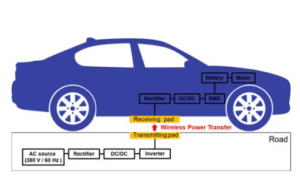 |
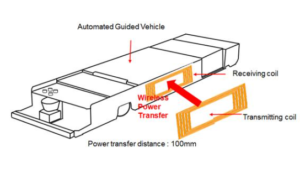 |
| WPT for Electric vehicles (15 kW) | WPT for AGVs(Automated Guided Vehicle) (4 kW) |
Electric vehicles (EVs) are environmentally friendly and cheaper than conventional fossil fueled vehicles. Therefore, demand for electric vehicles is expected to increase very rapidly in the future.
However, electric vehicles have various limitations, such as lack of operation time due to the limitation of the battery capacity and a high risk of electric shock during wired charging. Therefore, we are studying on applying a wireless power transfer system to replace the conventional wired charging system used in EVs. In addition, it will be applied not only to electric vehicles, but also to automated guided vehicles (AGVs), which play an important role in the unmanned systems of factories in the industry. If a wireless power transfer system is applied to EVs, many of the obstacles to the commercialization of EVs are expected to be solved.
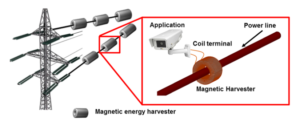 |
|
| Concept of magnetic energy harvesting system | |
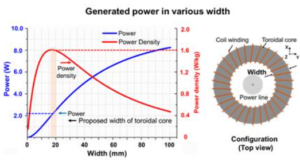 |
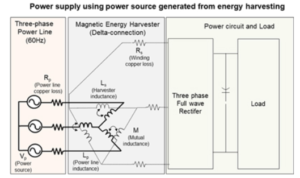 |
| Design of magnetic core | Harvester connection |
Power system requires constant inspection and preventive maintenance for proper fault-free operation. There are various devices to monitor and maintain the longevity of power system have been developed such as wireless sensors, brachiating robot, and so on. Most devices heavily rely on the battery which has a finite life span and is expensive to replace periodically. For this reason, magnetic energy harvesting is a promising technologies for self-sustainable operation of devices around power line. However, the magnetic energy harvester has a problem that magnetic core material is saturated at high current condition.
In our laboratory, we focus on the design of magnetic core with improved power density under the saturation condition. We verify the proposed modeling using Maxwell 3D EM simulation and measurement of the fabricated magnetic core using B-H Curve tracer. Furthermore, we actually implemented magnetic energy harvesting system to demonstrate in distribution system(22.9kV).
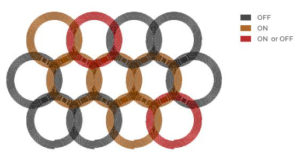 |
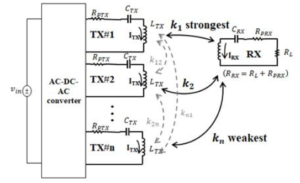 |
| Schematic of a multiple transmitters WPT system | Circuit model of a multiple transmitters WPT system |
Wireless power transfer (WPT) technology has been used in various applications such as smart phones, drones, pacemakers, and electric vehicles. However, when misalignment occurs, the efficiency decreases drastically. In order to solve this problem, usually a larger diameter transmitter(TX) coil is used to cover wide area. However, this approach has several drawbacks such as centralization of magnetic field and increasing EMF(Electromagnetic Field) problem. Therefore, we propose multiple TXs system that can make wide magnetic field uniformly and select optimal TX(s) to decrease power loss and EMF problem.
In our laboratory, we propose an optimal transmitter selection method for maximum power transfer efficiency that is robust against misalignment. Furthermore, we have plans for researches about receiver detecting method, EMF, EMI reduction method in WPT system using multiple coil, and so on.
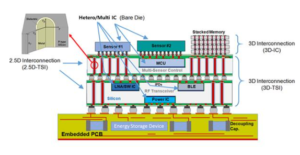 |
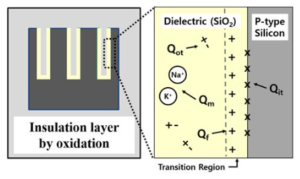 |
Through-Silicon Via (TSV) has emerged as the packaging technology capable of integrating heterogeneous system on the same platform. A typical TSV has a Metal-Oxide-Semiconductor (MOS) structure.
Chemical vapour deposition (CVD) or atomic layer deposition (ALD) can be used to deposit the SiO2 layer onto the Si substrate. During the SiO2 layer deposition process, the imperfections of charge type can exist in the SiO2 and at the Si–SiO2 interface. As the number of TSVs increases and the size of TSV decreases, oxide imperfections in TSV can cause serious problems in the system performance. To find optimal process condition for TSV formation, it is necessary to extract how much these imperfections are present in TSV under different process conditions.
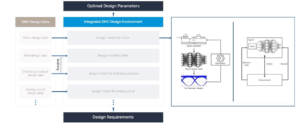 |
Low power and high integrated circuits are required due to the development of electronic devices. So that the complexity of the system increases. Therefore, various EMC problems, not previously occurred, are generated. Experts with many experiences designed with enormous time to solve these problems. However, due to the increased complexity of the system, EMC design requires more expertise and advanced technologies.
Therefore, EMC LAB is researching about EMC design using AI. Designing with AI changes various design parameters in complex systems with minimizing process. With AI, the optimal design that could not formulate in the past and the reduced simulation time such as EM and circuit are achievable.
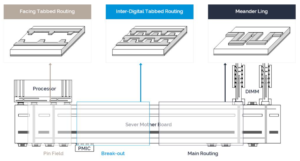 |
| A conceptual illustration of signaling channel application to server board |
In recent year, artificial intelligence technology is in the spotlight, and accordingly, it is required to improve the performance of the signaling channel of the server board. Thus, various channel patterns is studied for achieving signal integrity. To understand the characteristics of these various channel and design them to meet the demands of technology trends, signal integrity modeling is required. Through the signal integrity modeling, it is possible to design channels to meet next-generation needs through prediction and analysis on characteristics of each channel.
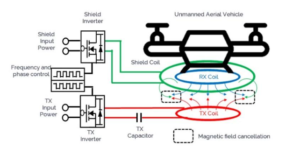 |
Currently, the utilizations of Unmanned Aerial Vehicle (UAV) are increasing, in the area of surveillance, geometric information, intelligent transportation system, and package delivery. However, the UAV has the on-board power limitation that is caused by the limited battery capacity, and battery capacity increases are accompanied by weight increase, so UAV operation will not be efficient. For this UAV limitation, the applications of wireless power transfer (WPT) technologies to the UAV are drawing attention.
However, the IPT systems for UAV charging require high electric power compared to the portable device. This means that the high density magnetic field will generate around IPT system. In addition, this strong magnetic field could be a leakage magnetic field. This leakage magnetic field influences the negative effect to human. The electromagnetic field (EMF) generating from UAV charger could be the severe safety issues compared to portable device. This is because that the IPT system of the UAV generates a high density magnetic field, but humans can adjacent to the charger like portable device. The active shielding system can be considered as the alternative to reduce the EMF of the IPT system. A principle of the active shielding is to eliminate the leakage magnetic field by generating the cancelling magnetic field. The cancelling magnetic field has the opposite vector direction with the leakage magnetic field so two magnetic fields are eliminated each other in terms of the phasor.
The active shielding system can be considered as the alternative to reduce the EMF of the IPT system. A principle of the active shielding is to eliminate the leakage magnetic field by generating the cancelling magnetic field. The cancelling magnetic field has the opposite vector direction with the leakage magnetic field so two magnetic fields are eliminated each other in terms of the phasor. The independent active shielding system is to supply shielding power from the independent power source. Power supply of the active shielding system is controlled corresponding to the strength and phase of the leakage magnetic field. Based on this control, shielding performance will enhance compared with the precedent shielding method.
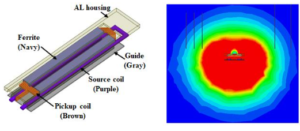 |
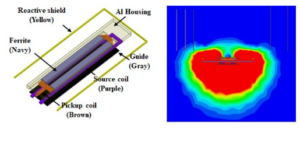 |
| WPT system without reactive shield | WPT system with reactive shield |
 |
|
| Principle of reactive shield | |
In order to reduce leakage magnetic field, Our laboratory has proposed the reactive shielding method. The reactive shielding method is to eliminate leakage magnetic field by generating cancelling magnetic field. The cancelling magnetic field has the opposite magnetic field vector with leakage magnetic field so leakage magnetic field is reduced by cancelling magnetic field. Reactive shield generates cancelling magnetic field by excited leakage magnetic field from TX and RX coil. The advantages of reactive shield is that low heat is generated than aluminium shielding, and application requirement is reduced then active shielding system. In addition, the reactive shielding method is accompanied by low efficiency decreases than precedent shielding method.
Wireless power transfer technology enables to charge electronic devices without any physical wire connections. To transfer the power wirelessly, the time-varying magnetic field is generated from the source coil. Unlike the transformer, the leakage magnetic field due to the large air gap between the coils cannot be neglected. As the WPT technology is more widely used, human exposure to time varying electromagnetic fields(EMFs) accordingly increases. Also, harmonic leakage electromagnetic field generated from WPT systems can affect other electronic application. A method for reducing the leakage magnetic field is required in order to commercialize wireless charging system. However, the conventional electromagnetic field reduction methods need to reduce the volume and weight of shield for implementation.
In our laboratory, we propose a planar resonant reactive shield to reduce the electromagnetic field and harmonic electromagnetic interference. Unlike the other conventional shields, the planar resonant reactive shield requires minimal additional size and reduce the leakage electromagnetic field with negligible degradation in power transfer efficiency.
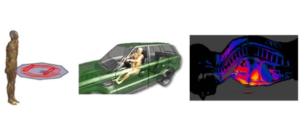 |
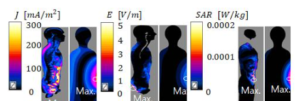 |
Currently, to consider the safety issues generated by the wireless power transfer (WPT) system, human exposure to EMF should be assessed and compliance with international safety guidelines and standards (ICNIRP 1998, ICNIRP 2010, IEEE 2002, and IEEE 2005). In particular, for an internal electronics inside the body, the human body exposure should be evaluated by the electromagnetic field radiation emitted from the external source, and also the effect on the device itself should be considered. In addition, if the internal device is charged by WPT, unlike the human exposure from the external source, power transmission and reception occurs via internal human medium, an appropriate assessment method should be developed.
GT642, Wireless Power Transfer System
GT506 (PD551), Fundamentals of Vehicular Electric Systems

Yujun Shin

Haerim Kim

Sungryul Huh

Andrés S. Brito Calderón

Seongho Woo

Yangbae Chun
